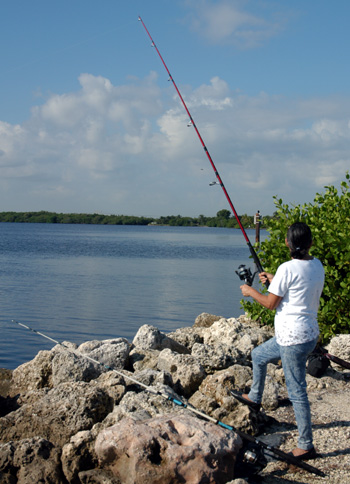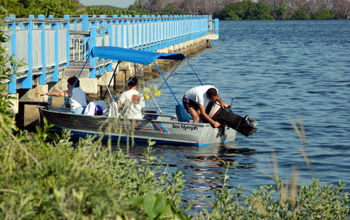
Best way to experience park? On bay…
HOMESTEAD, Fla.— One of the best ways to explore and experience Biscayne National Park is to get on a boat or get wet and get into water. Biscayne National Park, located on the southeastern coast of South Florida, is the only national park that is 95 percent under water.
Although Biscayne National Park is in the back yard of the big metropolis of Miami it is a place where visitors can experience life through exploring a spectrum of beauty the park has to offer. The park offers two ways to explore the under water environment and to experience the beauty first hand.
Biscayne has a snorkel trip and a diving trip visitors can choose from to experience the under water environment.
These trips though are all dependent on the weather that day.
 |
The best views at Biscayne National Park are underwater (Photo courtesy of the National Park Service). |
“If the weather is too rough on the outside with the winds and with five- to seven-foot seas and it’s rocking a rolling that is stirs up the sediment on the bottom and clouds the visibility, you won’t get a quality and safe so they wouldn’t go out,” said Susan Paishon, park ranger at Biscayne National Park.
There are two snorkel trips visitors can choose from. There is the bay snorkel or the reef snorkel.
The snorkel trips are offered everyday from 1:30-4:30 p.m. and last about an hour and 15 minutes. There is a brief 15-minute orientation offered by a park ranger 30 minutes before they sail out.
The park ranger briefs the visitors on what fish, coral, and different creatures they may encounter while snorkeling and a few tips on how to help the park preserve the under water environment. The ranger shows the visitors samples of coral and sponges they may see.
“The ranger tells you how to be stewards of the reef and how to help us protect the reefs from things not to do such as touch the corals, break the corals, or kick your flippers up so the sand covers the coral,” said Paishon.
“The purpose of the orientation is to help you help us to be stewards of the reef and also to make your trip more enjoyable so you know what you are looking for and what’s out there.”

|
| Fishing at the park’s Visitor Center can be done on shore or by small boat (Staff photos). |
The price of the snorkeling trip is $29.95 plus tax and includes the equipment of a mask, snorkel, fins and snorkeling vest.
This is one of the best ways to appreciate and experience the living under water environment of Biscayne.
The bay snorkel is a subtler snorkel and is called a nursery because everything is smaller in the bay than what a visitor sees in the reef snorkel.
“The bay is a totally different environment more of a hard-bottom sea grass community,” said Paishon.
The boat goes to University Dock, which is the bayside on Elliott Key or near Boca Chita Key.
The bay snorkel isn’t as great as the reef snorkel but visitors can still see a myriad of under water creatures. The bottom of the bay is an emerald, grassy meadow filled with diverse under water creatures.
Things visitors can see on the bay snorkel are vase sponges, thin finger coral, turtle grass, lined sea horses, split-lure frogfish and the occasional manatee. The bottom of the bay is kept clear by the ocean currents.
“There are a lot of species in the bay that you find at the coral reef, but because this is a shallow bay area this is more of a nursery area of the park so you find more of the infancy, juvenile phases of some of the adults you find in the reef,” said Paishon.
“The bay is a very awesome snorkel. Its just a different type of community than the coral reef snorkel.”
“The coral reefs are more like the Grand Canyon where the beauty is right there in front of you where your eyes are darting all over the place trying to take in everything at one time”
The reef snorkel is a more extravagant site compared to the bay snorkel. Visitors can see different types of coral and fish that it is an overwhelming experience. Visitors can see things from sea fans, sea plumes, damsel fish, glassy sweeper to brain coral chain moray, Coney, yellow head, Elkhorn coral, bled fire coral and reef urchin.
To get to the reefs for the snorkel trip, the boat leaves Convoy Point and passes through the south end of the bay through Caesar Creek and can either go to a site called Mile and a Quarter or to Shark Reef.
“The snorkel trip can be done on the glass bottom boat but there is a designated dive-snorkel boat special for that but the glass bottom is set up with a platform off the back where one can dive and snorkel off of that as well.”
The park also offers a dive trip to experienced divers. This trip is offered on Saturdays and Sundays from 8:30 a.m. to 1 p.m.
The price of the trip is $44.95 plus tax and includes only the air tanks. This trip is offered only to certified divers where they can explore the under water world. The diving sites these visitors go to are called the Drop and the Wall, right at the park’s boundaries.
“They dive to about 60 feet and in some places go to about 80 to 100 feet, but most of the dives the do in the park are referred to as medium to shallow dives,” said Paishon.
“These trips are all dependent on the weather and which ever boat is available at the time.”
The snorkeling and diving boats leave from Convoy Point, which is the park headquarters. On each snorkeling and diving boat is a captain and dive master. It is up to the discretion of the captain and dive master as to where the snorkel and dive sites will be that day.
The best times to go snorkeling and diving are in the summertime when the waters are still and clear. Winter is also a good time to take the bay snorkel when the waters in the bay are stiller and a bit warmer then in the reef area.
Besides the general snorkel and dive trips the park offers to the general public the boats can be chartered out to special snorkel trips or dive groups.
“Snorkeling is just awesome because you get in the resource with the fish where they don’t pay any attention to you and you just swim along and tons of things will be revealed to you,” said Paishon.


Comments are Closed